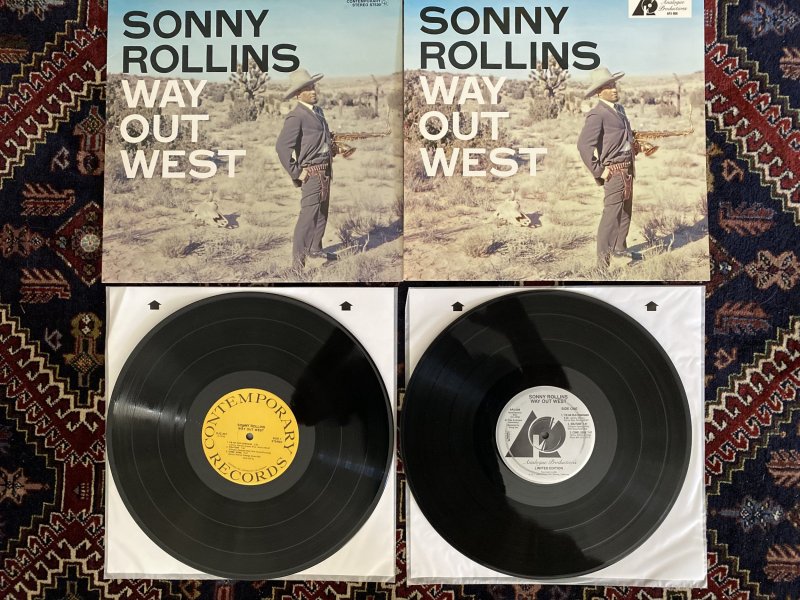Back to what I am hearing in my room comparing these two turntables.
I have very few examples of both audiophile reissues on heavy vinyl and copies of earlier pressings of the same titles. My friend MadFloyd was kind enough to lend me or give me a re-issue of Sonny Rollins Way Out West on Contemporary, CR S7530. It is an earlier pressing on thinner vinyl. Ian does not like this pressing and describes them as somewhat “hot“ sounding. I’ve been comparing this recording with my reference re-issue on Analog Productions, APJ 008.
The original American Sound AS 1000 turntable more clearly illustrates the differences between these two recordings than does the Micro Seiki SX 8000 II.
I am not going to post videos of the two recordings, but I will try to describe what I am hearing.
The first difference is that the older pressing sounds louder. This was not very obvious to me before. I turneded my volume controls down two clicks for a perceived similarity in loudness. I then been pulled out my digital sound level meter and compared the relative loudness of each pressing using the first track. The older pressing started at 65 dB and had a peak of 85. The newer pressing started to 61 and peaked at 84. The newer pressing seems to have a slightly greater dynamic range, at least on that first track. My initial impression that the older pressing seems louder is confirmed by the measurements at the beginning of the track.
That’s kind of interesting, but I generally adjust the volume level until I think it sounds about right for how I want to listen to a particular recording. Much more interesting to me is the quality of the sound I am hearing. The new pressing sounds like there is more contrast between the instruments created in part because the background seems quieter and the instruments are standing in bolder relief. But there’s also a spotlighting of the instruments that draws my attention to each one. It separates them. I also hear a slight lack of life in the presentation. It is a display rather than a performance. Images are also just a tad flatter sounding. Each instrument seems slightly enhanced.
I do not hear the “hot” balance on the older pressing. What I do here is slightly more energy and life in the presentation. The instruments do not play in as much contrast to each other but they are jamming more convincingly. There is slightly more balance. There is less contrast and void between images. There is more sound filling the space around them. The bass is less pronounced drawing less attention to itself. It is more like I think of a bass being played right next to a drum set. The saxophone is the star during the solo with the rhythm section falling back. It then rejoins the others to become part of the mix, when all the instruments are improvising.
It is pretty interesting. I can see how people would prefer one or the other presentation. I like them both but slightly prefer the older pressing, basically because it sounds more like I am in the presence of the musicians.
The cool thing for me, as I sit here listening to these differences, is the realization that a turntable like the original American Sound helps me to better understand both the minutia of a particular recording and at the same time allows me to choose a particular presentation that sounds more natural to me in my living room. This turntable gives me greater insight into both the recording and the music. I heard this difference between pressings in David’s room with his AS 2000. Having the AS 1000 here is giving me similar insight which the Micro does to a slightly lesser extent. It is a real treat.
This analysis is great and I’m learning something, but I mostly enjoy just putting on the next record and listening to it. Thank you Ian for allowing me to hear this LP in my system.



